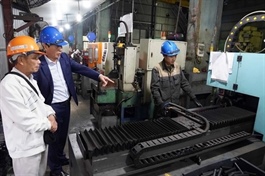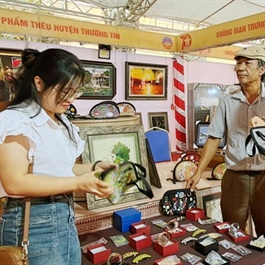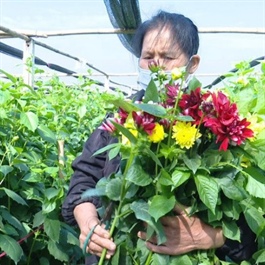Traditional traders face obstacles with livestreaming
Traditional traders face obstacles with livestreaming
Despite livestreaming having become a popular e-commerce trend followed by many traders and companies, it remains a challenge for sellers at traditional markets.

Traders at a traditional market study to livestream. Livestreaming remains a challenge for sellers at traditional markets. — Photo vneconomy.vn |
Towards the end of last year, HCM City authorities collaborated with e-commerce platforms to assist vendors at traditional markets in transitioning to digital platforms. This initiative was seen as a positive signal for traders as this co-operation was believed to help vendors improve sales following the impacts of COVID-19 and the economic downturn.
However, nearly a year later, the results of these efforts have been modest as most traditional traders still prefer traditional trading methods.
The reasons why live-commerce is less attractive include traditional selling habits, high costs, and a lack of technical expertise in utilising technology among traders at traditional markets.
Bến Thành Market, the most famous traditional market in HCM City, was the first market to pilot a plan to help vendors go online by enlisting the support of various Key Opinion Leaders (KOLs), Key Opinion Consumers (KOCs), and livestreamers. Initially, there was much excitement. But over time, many traders did not embrace online selling.
Sharing with tuoitre.vn, Nguyễn Thị Trang, owner of a confectionery shop at Bến Thành Market, mentioned that although she has accounts on multiple social media platforms like Facebook, Zalo, and TikTok, she stopped livestreaming after just three sessions.
Trang expressed a preference for traditional purchasing methods, noting that online customers were hesitant to buy and that additional shipping costs were a deterrent.
Similarly, Bùi Thị Lụa, owner of a clothing shop, was initially enthusiastic about participating in training classes but still prefers traditional methods. She highlighted the influence that TikTokers, KOLs, and KOCs have in e-commerce, indicating that traditional traders lack the same level of customer engagement.
As a young seller with various online sales channels such as a Facebook fan page, a YouTube channel, and a website, Lý Đại Lâm, the manager of a curry stall in Bến Thành Market, explained that the effectiveness of online business has been moderate given the unique characteristics of each market and product.
A representative of Bến Thành Market's management board stated that despite providing livestream sales training sessions on TikTok for over 1,100 small traders, the market has not organised any additional training sessions since the beginning of the year. This decline in enthusiasm is partly attributed to the reluctance of many elderly market vendors to adopt online selling due to a lack of technical skills.
While traders cite various reasons for their hesitation, platforms offering livestream commerce and KOLs have their own perspectives. KOL Vũ Bích Hồng, who has trained traditional traders in successful livestreaming, noted that many businesses fail to recognise the benefits of this sales method and discontinue livestreaming once the training ends.
In a statement to Việt Nam News, a live-commerce platform representative admitted that there is a disconnect in product selling practices between platforms and traders.
Traders at traditional markets often refrain from listing prices as they prefer to engage in price competition and bargaining with customers. For traders still using counterfeit products, fake items, and lacking professional livestream capabilities, it becomes challenging to comply with e-commerce platform guidelines.
She confirmed that not many vendors have livestreamed on her company’s platform.
Ultimately, failing to adapt to current trends will place traders at a disadvantage, especially when competing with foreign rivals who often offer better pricing and have better marketing strategies.























